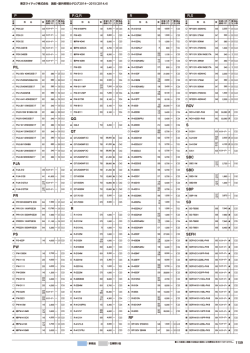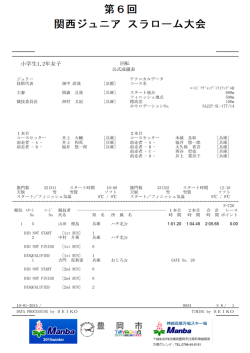
宇宙背景放射 EBL: ExtragalacFc background light (紫外線から近
宇宙背景放射 EBL: Extragalac-c background light (紫外線から近赤外線) 木曽シンポジウム 2014, 7/10-‐11 コスモス会館 川良公明(天文センター) EBL(Extragalac-c Background Light) -‐-‐ 銀河 -‐-‐ IGM(ダスト、ガス、星) Dark Stars sical Journal, 745:166 (7pp), 2012 February 1 Maurer et al. WIMP D M p owered s tars -‐-‐ Exo-c energy release Table 1 10 Dark Star Parameter Range Sciama+1997 L /M ∆t z SFR 10 10 15 10 10 Maurer+2012 10 10 10 10 10 10 5 10 imum value of LMR is close to the Eddington limit and therefore upper boundary for the DS parameter space. 10 前景放射 a simplification, a constant SFR over a certain od is assumed which can be expressed as a mass te in units of M気による散乱 yr Mpc : -‐-‐ 大 ! 10 0.1 for z ! z ! z SFR 1 10 100 (z) =-‐-‐ 点源(星) (5) Wavelength [µm] 0 elsewhere, Figure 3. Two different DS parameter sets (red dashed: T = 7500 K, M -‐-‐ 黄 道光(ZL) = 690 M ; blue dashed: T = 5000 K, M = 106 M ). Both models are is a normalization factor, varied in the range calculated with SFR = 10 , ∆t = 10 years, z = 5. Gray markers: bove, z indicates the minimal value of redshift EBL measurements and limits adopted from Mazin & Raue (2007); gray: upper -‐-‐ 銀 河拡散光(DGL-‐ダストで散乱された星の光) formation can still occur, and z denotes the limits from TeV observations (realistic model) from Mazin & Raue (2007). the DS formation epoch. The ansatz for the SFR Black: EBL lower limit by Kneiske & Dole (2010). The total EBL shape in the presence of a DS contribution is the sum of the lower limit and the specific DS paper is strongly simplified and more elaborate 2 DS 5 ⊙ 7 5 9 Norm −7 −5 −3 1 -2 3 min -1 2 νIν [nW m sr ] ⊙ ⊙ 0 −3 −1 -1 Norm min max DS Norm ⊙ min max Norm DS −3 DS 9 ⊙ min 木曽観測所におけるDGL研究 Ienaka+2013 DGL-‐IMS emission(100um)の関係は、 op-cally thinの条件では線形 I(DGL) = b*I(ISM 100um) | | absorp-on of starlight ScaUering of starlight 線形関係からのズレ à 星、黄道光の差し引きに異常 MBM32 分子雲 2KCCD 45’x40’ The Astrophysical Journal, 767:80 (12pp), 2013 April 10 DGL – 100um 相関 Ienaka et al. DGLスペクトル b = DGL/100um The Astrophysical Journal, 767:80 (12pp), 2013 April 10 Ienaka et al. Figure 6. Correlation slopes b(λ) = ∆Sν (λ)/∆Sν (100 µm) as a function of wavelengths. Table 2 DGL Model Parameters 傾きbは、100umの強い方向ではサチル – op-cal depth 効果 Band S (λ) = a(λ) + b(λ)S (100 µm) S (λ) = a (λ) + b (λ)S (100 µm) + c (λ)S (100 µm) 0.65-‐0.9umはデータの空白地帯、フリンジのために拡散光が測れない a(λ) b(λ) a (λ) b (λ) c (λ) (kJy sr ) (×10 ) (kJy sr ) (×10 ) ((kJy sr ) × 10 ) àOH emissionを避けたM815フィルターを木曽に整備 B 195.23 ± 0.12 1.61 ± 0.11 194.28 ± 0.50 2.17 ± 0.28 −0.08 ± 0.04 ν ν Q ν Q −1 g 299.16 ± 0.16 −3 2.25 ± 0.14 Q ν Q −1 298.00 ± 0.60 Q 2 ν Q −3 2.80 ± 0.34 −1 −1 −0.07 ± 0.04 −6 BO (Before ours) Domimguez+2011 VHE γ-‐ray limitと矛盾 VHE γ-‐ray による上限値 γ(VHE) + γ(EBL) -‐> e+ + e-‐ λ(EBL) = 1.24(E/TEV)um LETTERS dN/dE = N0E-‐Γ Γ <1.5はBlazar physicsと矛盾 Figure 2 | The HESS spectra of 1ES 11012232, corrected for absorption with three different EBL SED values, as labelled in Fig. 1. Red, observed data; blue, absorption-corrected data. The data points are at the average photon energy in each bin, also used to calculate the optical depth for This result is also insensit intrinsic slope. A different v results, will shift the limit a differences would qualitativel Aharonian+2006 of G int ¼ 1.0 would loosen th Alternative scenarios which Z=0.186 blazar with high O–NIR fluxes form discovery in their own right, given their exotic implicatio the intrinsic spectra softe (.300 nWm22 sr21; see Fig. other measurements1,26, and c reasonable cosmological mod A more viable alternative is feature of the TeV blazar emiss been envisaged6. For exampl mono-energetic electrons (E 0 bulk motion Lorentz factor) regime with a narrow-band distribution), may lead to very at e g < E 0, reproducing spect features should become direct closer, less absorbed objects o AO(Ajer ours) Matsuoka+2011 Pioneer 10/11 – launched 1972-‐72 IPD cloudの外(R>3.2AU) PioneerのOp-cal EBL は Galaxy counts に一致 -‐> HST(WFPC2)はZL混入、IRTS, COBE/DIRBEにも混入? urnal, 736:119 (14pp), 2011 August 1 EBLの再評価(1AU) HST FOS – 0.2 – 0.7 um 54 fields – 728 spectra 前景放射 -‐-‐ 大気散乱ß Nighome -‐-‐ 点源(星) -‐-‐ 黄道光(ZL) ß 難しい! -‐-‐ 銀河拡散光(DGL) 0.015 0.4 0.010 0.2 0.005 RSD (MJy/sr) RSD (MJy/sr) 0.12 0.8 0.10 成分分離 Obs = ZL + DGL + Residual 0.6 (b’) PRISM 0.27µm 0 - 50 MJy/sr 0.4 ZL = a*ZL(1.25um) :ZL(1.25um) = DIRDE ZL model DGL = d1*(I100um) – d2*I(100um)^2 0.2 第2項 satura-onを考慮 0.180 0.0 1 – exp[-‐d*I(100um)], arctan[d*I(100um)]でもよい? 0.113 0.047 ZL分離(Obs – DGL vs ZL 0.5model) 0.7 -0.020 0.0 DGL分離(Obs – Z0.3L vs 10.4 00um) 0.1 0.2 0.3 0.4 0.6 0.1 0.2 0.5 10 20 model (MJy/sr) 30 Zodiacal 100µm (MJy/sr) 40 50 0.12 0.10 Obs - DGL (MJy/sr) 0.080.6 0.06 0.4 0.04 0.02 0.2 0.00 RSD (MJy/sr) 0.113 0.113 0.047 0.047 0.12 0.7 (d’) PRISM 0.55µm 0 - 50 MJy/sr 0.08 0.06 0.04 0.02 0.00 -0.020.0 0.180 0.180 -0.020 -0.020 0 0.0 0.6 Zodiacal model (MJy/sr) (d) PRISM 0.55µm 0 - 20 MJy/sr (c’) PRISM 0.55µm 0 - 50 MJy/sr RSD (MJy/sr) RSD (MJy/sr) .7 (c’) PRISM 0.55µm 0 - 50 MJy/sr Obs - DGL (MJy/sr) 0.6 0.020 0.000 0.0 0.180 -0.005 0.02 0.113 0.01 0.047 0.00 -0.020 -0.01 0.0 20 0 Obs - ZL (MJy/sr) 0.8 RSD (MJy/sr) Obs - ZL (MJy/sr) Obs - DGL (MJy/sr) 0.025 Zodiacal model (MJy/sr) (c) PRISM 0.55µm 0 - 20 MJy/sr Obs - ZL (MJy/sr) 0.8 0.1 5 0.2 0.3 10 0.4 0.515 Zodiacal (MJy/sr) 100µmmodel (MJy/sr) 0.6 0.7 20 -0.02 0.180 0.113 0.047 -0.020 0 10 20 30 100µm (MJy/sr) 40 50 r) (d’)the PRISM 0.55µm 0 -at 50 0.27 MJy/sr e 5. Fitting to PRISM data and 0.55 µm. The left and right panels show fits to the 0 - 20 and 0 - 50 MJy sr−1 sa 0.10 tively. Iν,i (Obs) − Iν,i (DGL) (i.e., Iν,i (ZL) + Iν,i (RSD)) against the ZL model flux is plotted in panels (a), (a’), (c) & (c’) 黄道光のスペクトル (0.2 – 3 um) I (nW/m2/sr) 1000 ZL 10000 100 (a) 10 0.2 0.3 0.4 0.5 0.6 0.8 1.0 (µm) 2.0 黒丸 -‐ HST FOS, 白丸(compiled by leinert+1998) 近赤外 – IRTS(Matsumoto+1996), CIBER(Tsumura+2010) (b) 1.4 点線 – 太陽スペクトル 紫外線で弱い、 近赤外線に超過 1.2 3.0 UV to optical background emission DGLスペクトル 11 ●-‐ HST FOS, ○ -‐ Pioneer, 菱形 – GALEX ν bi (nW/m2/MJy) 100 DGL spectrum: Correlation slope ZDA04(BC03) × 2 WD01 10 ZDA04 1 0.15 0.2 0.3 0.4 0.5 0.6 λ (µm) 0.8 1.0 Residuals(>0.3um) ZL-‐dominant, EBLにあらず K.Kawara, K.Sano and Y.Matsuoka Pioneerとの差はZL residualsによるものとする EBL = Residuals – ZL-‐residuals EBL Galaxy counts – op-cal/near-‐IRで一致 UVではEBL超過 (Exo-c?) Panel (a) Illustrates the residuals from far-UV to near-IR wavelengths along with the missed ZL component. The da the extended part of the missed ZL component. The missed ZL spectrum up to 2.5 µm is 0.0217 × the ZL spectrum sc −1 given by Kawara et al. (2014), while the extended part is 0.0217 × the ZL spectrum by the DIRBE model. Pane e diffuse EBL with the desecrate EBL from galaxy counts. The discrete EBL refers to Gardner et al. (2000) at 0.16 and t al. (2001) at 0.3, 0.45, 0.61, & 0.81 µm and Ashby et al. (2013) at 3.6 and 4.5 µm. Panel (c) compares with the limi 以前から指摘されていた超過は、GALEXで否定されたのだが,ここで復活 ys. VHE γ-‐ray limitは全波長域で矛盾せず
© Copyright 2026

